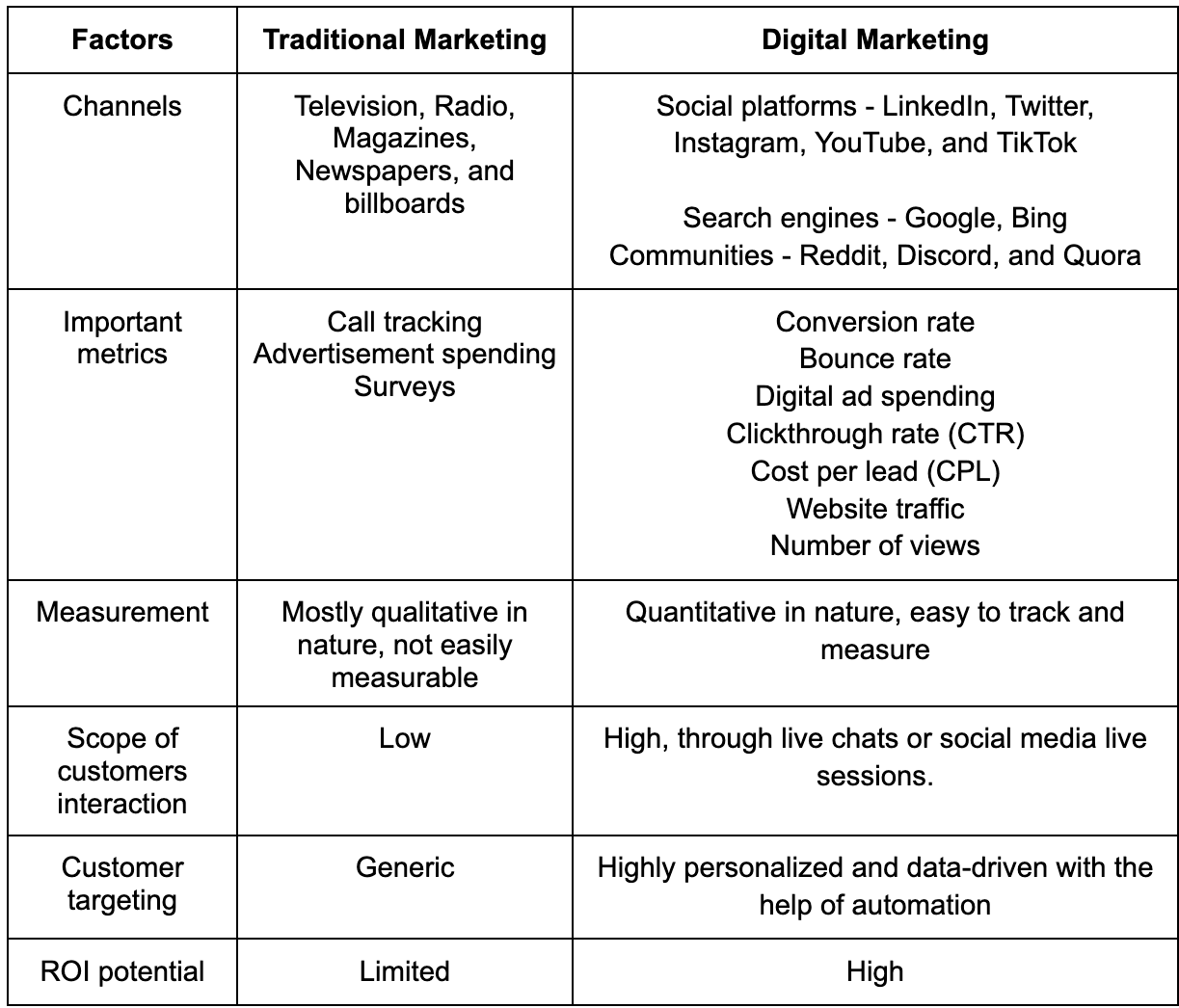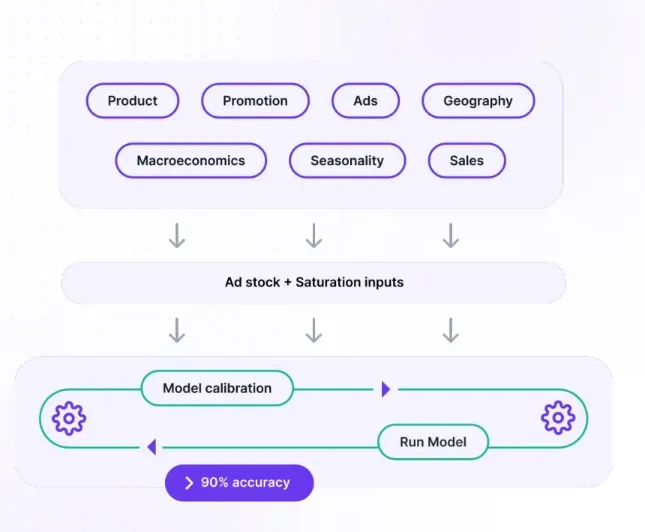According to Gartner, digital platforms accounted for 56% of total marketing channel spending in 2022. Platforms like Google Ads, LinkedIn, and Facebook play an integral role in modern marketing.
Quarterly or yearly marketing budgets are set based on the effectiveness of multi-channel digital marketing efforts. For this, CMOs perform in-depth analysis of diverse digital channels to develop strategies that reduce spend and maximize ROI.
To perform such analysis, they need authentic data points. However, there is widespread awareness about the ethical implications of cross-app user data sharing. Brands like Apple and Google have even introduced more privacy-friendly data frameworks to limit the sharing of personal data.
As a result, Marketing Mix Modeling (MMM), a famous concept introduced in the 1950s, is gradually making a comeback in an increasingly cookieless world.
MMM Modeling is a smarter way to analyze and optimize multi-channel marketing efforts. Unlike a marketing attribution tool, Marketing Mix Modeling doesn’t focus on user-level data. It bases its analysis on aggregate datasets such as ad spends, social outreach, sales, impressions, and more.
Marketing Mix Modelling Components
The foundation of any Marketing Mix Model is its four components – Product, Price, Place, and Promotion.
Marketing Mix Modeling components explained in detail below:
Product
The first “P” in the Marketing Mix stands for Product.
Product (or service) refers to the object that a brand sells to customers. Knowledge of the product and its features is not enough for marketers. You must also understand the needs of your target audience and how the product benefits your customers in different stages of the buyer’s journey.
Apart from this, you must know the following:
- The pain points and challenges your product solves
- How your product compares to that of your competitors and where it stands out
Knowing all these aspects well can make your advertising campaigns more targeted and value-driven.
Role in Marketing Mix Modeling
As a part of MMM Modeling, you need to dive deeper to track various product metrics like sales volume, customer satisfaction rate, and customer retention rate. All these are dependent variables that control the performance of your Marketing Mix Model.
Let’s take the example of the global ecommerce giant, Amazon, and how its growth was propelled by adding different products to its Marketing Mix Model.
Amazon began its journey as an online retailer in the late 1990s. Back then, the only product it was selling was books. It was a smart choice, considering books were one of the few products with universal demand. So much so that in 1997 alone, Amazon earned $148 million in sales by selling only books.
The success of this venture made its founder, Jeff Bezos, realize that global shoppers were fond of buying products online and were ready to pay for the convenience of getting their desired products delivered to their doorsteps. As a result, Amazon started adding new products (like music, computer games, clothes, and so on) to its Marketing Mix every year while keeping track of product metrics like sales volume and market demand. Soon, Amazon became the online “Everything Store” Jeff Bezos had always dreamed of.
Price
Price is the second “P” in Marketing Mix Modeling.
It represents how much a brand charges for a product (or service) from their customers. Although marketers do not build pricing strategies, any change in pricing directly impacts the performance of marketing campaigns.
Therefore, they should know the following considerations behind setting up a marketing strategy:
- Make sure you know the brand’s perspective on choosing a particular pricing strategy. If your company sells a luxury product with a high manufacturing cost, you may be allowed to reduce its price or offer aggressive discounts on the item to boost campaign conversion.
- A pricing strategy also helps with lead conversion. If your product has a freemium model, the possibilities of conversion increase. Similarly, conversion possibilities may be reduced if your brand doesn’t have a free trial option and prospects are forced to buy a specific plan to explore the product.
Role in Marketing Mix Modeling
Marketers must be aware of factors like price changes, promotional pricing, and competitor pricing to understand how pricing impacts ROI.
For example, all top OTT platforms like Netflix, Hulu, and Amazon Prime offer subscription-based pricing to their users. These brands have several tiered plans targeted at different user groups.
Even though there are differences in their exact pricing, it is clear that all these brands use a competitive pricing strategy as part of their Marketing Mix Models. Their ROI depends on how many monthly/yearly subscriptions they acquire; these factors control their MMM Models.
Place
The third “P” in a Marketing Mix Model stands for Place.
Here, “place” signifies where your products are available for the customers to explore and purchase. Earlier, “place” represented brick-and-mortar stores only, things have changed now. Today, a brand sells products in multiple places like offline and online stores, social media platforms, and more.
You may or may not be responsible for deciding where your brand’s products will be available. However, it is still essential to find answers to the following questions:
- Which geographies should my product be available in?
- Which distribution channels are being used to sell my product?
- Which channel is more profitable? Digital or offline?
- Which channels are most effective for my target audiences?
Role in Marketing Mix Modeling
Different places or distribution channels have different potential. For example, if a new brand decides to sell its products through top e-retailers like Amazon, it is easier to boost its reach as compared to selling the products through its ecommerce website. The reason is that Amazon has a 514 billion user base in the US alone as of 2022, while a new ecommerce website will need time and dedicated search engine optimization (SEO) efforts to boost its reach.
Therefore, CMOs must integrate these factors to develop a Mix Model that provides detailed insights into the ROI potential of different “places” or distribution channels.
Promotion
The fourth and final “P” in an MMM Model stands for promotion. Promotion is directly associated with a brand’s marketing function because it represents how the brand communicates the value of its product to existing and potential customers.
Promotion includes multiple digital channels like social platforms, SEO, digital ads, emails, PR campaigns, and offline channels like radio ads, television ads, newspaper ads, billboard ads, and more.
Here are aspects you should be aware of:
- What type of content/creative works for which channel?
- Which message is driving the highest number of clicks and impressions?
- What does the customer journey for your brand look like?
- Which types of campaigns work for which groups of customers?
Role in Marketing Mix Modeling
Each promotional activity performed by a brand should be evaluated based on factors like sales, impressions, clicks, ROI, and so on. All these metrics determine the success rate of different campaigns and simplify the channel-based budget allocation for the upcoming financial year.
Returning to Netflix, this brand had a marketing budget of $2.5 billion in 2022. Nevertheless, the global streaming marketplace is getting hugely competitive, and Netflix has a limited marketing budget, considering it spends $17 billion a year on programming.
Recently, Marian Lee, the marketing chief of Netflix, said that spending on ads no longer results in more viewers. As a result, the brand is shifting its strategy and focusing more on establishing itself as a content organization.
“I’m trying to enable creativity to bring this content to more people worldwide. I also want the rest of Netflix to understand the marketing strategy: We support the content organization,” says
— Marian Lee.
This explains how Netflix is ready to shift its promotional strategy from paid advertising to content-based marketing by tracking one of its significant KPIs – an increase in viewers. This shift has been possible due to this OTT brand’s careful monitoring of its MMM and making informed decisions based on the outcomes.
Why is Marketing Mix Modeling Important?
Marketing Mix Modeling provides brands with a holistic overview of their marketing campaigns.
For example, you might have taken all the right strategies for your brand a power-packed website, comprehensive content, and creative ad campaigns. But that’s not where it ends. In fact, it is just the foundation you built. And once the foundation is ready, you need a roadmap to keep going.
Marketing Mix Models provide you with that exact roadmap. These models analyze sales data alongside different marketing initiatives to identify their effectiveness and help a marketer plan the next steps.
Here’s why MMM Modeling is important:
- MMM evaluates the performance of multi-channel campaigns to showcase which channels are most profitable and contribute to maximum ROI and which are least profitable and can be discontinued.
- Once you evaluate various marketing campaigns and list the insights, MMM Modeling helps you deploy those insights to streamline your marketing efforts.
- Marketing Mix Models forecast sales based on historical data and identify the potential negative factors that affect a brand’s performance in the long run.
- MMM Model is relevant in a world with privacy-focused customers and policies. For example, the General Data Protection Regulation (GDPR) mandates a “cookie-less” business landscape, making it hard for marketers to use cross-app user data.
Marketing Mix Modeling analyzes aggregate datasets to conduct in-depth analysis and doesn’t consider users’ personal data.
Traditional vs. Digital Marketing – What are the Differences?
Traditional marketing refers to conventional marketing techniques like television, radio, print, and billboards before digital channels existed. These marketing channels used to be popular until the early 1990s.
However, digital marketing has been ruling the world since the early 2000s, and some of the essential digital channels include social media platforms, search engines, and online communities.
Marketing Mix Models have also evolved over the years and can analyze the performance of a brand’s traditional and digital marketing initiatives.
You must be aware of the key differences between traditional and digital marketing to leverage the MMM framework more effectively:
Differences between traditional and digital marketing
While it appears that MTA offers more advantages for marketers because you can track every click, every ad, and every channel. MTA is falling short owing to signal loss caused by cookie and privacy first compliances. Furthermore, as your marketing budget grows and you have several channels, cross-channel macro optimizations such as budget reallocation or incremental lifts provided by one channel vs. the others become crucial, which MMM solves.
How does Marketing Mix Modeling Work?
An MM Model uses statistical methods like multi-linear regression to analyze the relationships between dependent and independent variables and how they impact a brand’s overall sales.
Marketing Mix Modeling step by step breakdown
Step 1: Data Collection
Marketers start with identifying data repositories and data points specific to the business goals and integrate these sources with the MM Model to expedite the data collection process.
Contrary to Marketing Mix Modeling myths, data quality matters in this framework. Hence, focusing on granularity is important at this stage.
For example, if you are measuring the performance of an email campaign, MM Modeling will focus on metrics like open rate, unsubscribe rate, CTR, and more. Nevertheless, the outcome depends on how granular these datasets are.
Therefore, you should partner with reliable email marketing service providers that offer authentic, correct data to feed your MMM model for appropriate outcomes.
Some of the most common data types that work as inputs for an MM model include:
- Weekly, monthly, or quarterly sales data
- Cross-channel marketing expenditure vs. cross-channel sales
- Various external factors like competitors’ activities, latest trends, seasonality, distribution
- Internal activities like IPO launch, funding rounds, and price changes
Step 2: Models and Data Analysis
Next, it is time to develop the Marketing Mix Model. Based on the analysis of the datasets, brands can develop different types of statistical models. Some popular statistical techniques associated with these models include time series, linear regression, and multi-linear regression.
This model estimates factors like sales data and internal and external factors (mentioned previously) to identify the relationship between sales and marketing initiatives.
In the analysis stage, an MM model opts for coefficient analysis to determine which of the variables (internal and/or external) has the most substantial impact on the brand’s overall sales. It further identifies the optimal level of implementation for each variable to maximize overall sales.
Marketing Mix Model
Step 3: Generating Insights
By the end of the analysis stage, businesses should be able to derive critical insights from the Marketing Mix Model.
In this stage, marketers can find answers to the following questions:
- Which elements affect sales directly?
- What is the cost vs. ROI scenario for each marketing channel?
- What percentage of sales lift can be expected if you increase the budget of a certain channel by XX%?
- What is the saturation point of a marketing channel?
- What will be the expected sales for the upcoming quarter?
The Marketing Mix Model helps marketers with intuitive visualizations to decode the relationship between variables and sales in a more straightforward manner. CMOs use these visualizations to communicate the performance of marketing initiatives with other stakeholders.
Decode relationship between variables and sales
Source
Step 4: Iteration and Validation
The final stage is to iterate your Marketing Mix Modeling based on the insights derived.
A critical part of this stage is to conduct a “what if” analysis for your brand. The outputs of an MM model look like equations that represent relationships between various variables.
As part of the “what if” analysis, marketers can change the inputs for different variables to identify the optimal point that provides maximum ROI with minimum cost.
Suppose your Marketing Mix Model shows that LinkedIn is the most profitable paid channel for your brand. By investing 10% of your marketing budget, you are currently generating 35% of the overall ROI from this channel.
In the iteration and validation stage, you can change the percentage of the overall budget and keep increasing it to identify how your ROI will also change.
While changing inputs, there will come a point where, despite increasing the budget, the ROI will become static. The takeaway here will be that even though LinkedIn is a profitable channel for your brand, beyond a certain point, it will not be effective, even though you keep increasing the budget.
Hence, you got to know about marketing mix modeling step by step. Now you can plan the marketing mix accordingly and start exploring other channels to strike a balance.
Final Thoughts
Marketing Mix Modeling is a great way to analyze the effectiveness of your marketing initiatives. Nevertheless, it is a costly framework and only Fortune 500 companies with budgets over $500K can afford this model. Additionally, an MMM Model takes close to 6 months to analyze large data volumes and produce results.
Does that mean MMM Models are out of reach for mid-level organizations? Not really, as there is an alternative called an automated Marketing Mix Model developed by Lifesight.
Lifesight optimizes your existing marketing mix with a processing time of just 18 months. Additionally, this tool can:
- Train your Marketing Mix Models within 45 minutes and test different budget scenarios to optimize the budget allocation process
- Help marketers allocate appropriate budgets to the appropriate marketing channels to avoid overspending
- Auto-calibrate your Marketing Mix Model to scale operations.
Want to know more? Schedule a demo now!
You may also like
Essential resources for your success



















